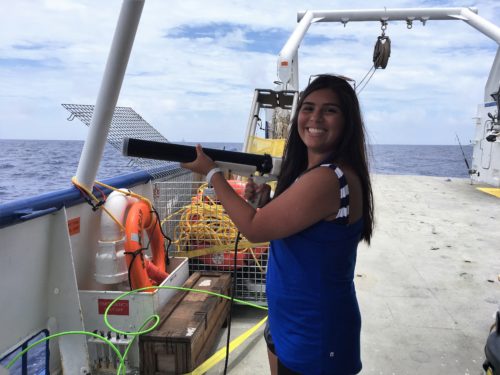Written by: Alexandria Hahn
Edited by: Amy Whitt
The XBT, or expendable bathythermograph, is a device which records temperature as a function of depth. This essentially allows those analyzing the data to determine how fast sound can travel in the water at different depths, which is really important on our expedition because we are studying marine mammal sounds underwater.
Because the XBT can be used when the ship is moving, it doesn’t interfere with other ongoing operations and is typically used opportunistically. When the XBT is deployed into the water, a thin copper wire connects the XBT to the system on the ship so that the data can be viewed in real time and recorded. These XBTs give scientists great oceanographic data at various depths.

I learned that XBT deployments are a sort of rite of passage on research cruises. Because I was the newest, most inexperienced scientist on this cruise, everyone insisted that I get the opportunity to launch an XBT. When the time came for me to “shoot” the launch gun which holds the XBT, I was very excited. The XBT is torpedo-shaped so that it can quickly travel through the water. I didn’t get much of a tutorial before I was handed the XBT launcher. I was simply instructed to remove the clip in order to release the XBT into the water.
Before I went to pull the clip, I heard Amy say “brace yourself!”. I then went for it! I did not anticipate how tight the clip would be, and I couldn’t get it on my first few attempts. Those watching tried to instruct me, and I finally got it! The XBT simple slid out of the launcher into the water, virtually making no sounds and producing no kick-back. It was sort of anticlimactic, but the device was in and all that was left was to hold the launcher as the copper line uncoiled and wait for the XBT to hit the bottom of the seafloor.
When it was at the bottom, we could see a flat line in the data on the computer screen. Then, we just tore the copper line and were finished. The data could then be analyzed and put to use. I was happy to make a new experience on the ship, and now I can tell people all about this and other data collection methods that we used on this research expedition!
***This blog article is part of our LADC-GEMM 2017 Survey blog series. Check out more articles in this series here, on the LADC-GEMM website, and on Alexandria Hahn’s blog. Also, be sure to “Like” the new LADC-GEMM Facebook page!***

